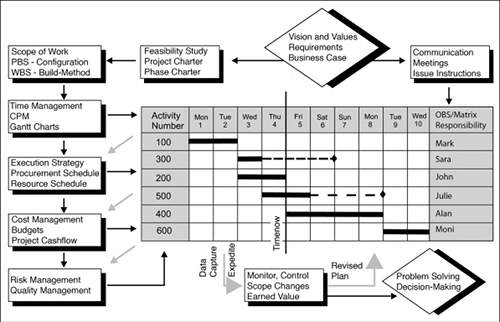back to PROJECT MANAGEMENT Series
Book 2 PROJECT MANAGEMENT TECHNIQUES 2ed College Edition
by Rory Burke
Project Management Techniques 2ed (College Edition) is fully updated to include the latest project management processes and methodologies as outlined in the new PMBOK 5ed (2012) and the new APM BoK 6ed (2012). Project Management Techniques for project management courses has been updated to enable the project manager to use the latest planning and control techniques, processes and methodologies to complete their projects successfully. This is often expressed as completing the project deliverables on time, within budget and to the required quality. It is, therefore, essential the project manager understands the features and characteristics of the project management systems approach to be able to manage the process effectively.
Support Material:
A CHAPTER’S GUIDE and POWERPOINTS SLIDES are available upon request. Please click HERE to complete the request form.
Table of Contents:
Chapter 1: Introduction to Project Management
Chapter 2: Project Lifecycle
Chapter 3: Project Management Process
Chapter 4: Project Methodolgy
Chapter 5: Project Stakeholder Management
Chapter 6: Corporate Strategy Phases
Chapter 7: Project Feasibility Phase
Chapter 8: Project Definition Phase
Chapter 9: Project Execution Phase
Chapter 10: Project Commissioning and Handover Phase
Chapter 11: Operational Phases
Chapter 12: Project Plan
Chapter 13: Project Scope Management
Chapter 14: WBS
Chapter 15: Project Time Management
Chapter 16: CPM
Chapter 17: Gantt Charts
Chapter 18: Project Procurement Management
Chapter 19: Project Resource Management
Chapter 20: Project Cost Management
Chapter 21: Project Cash Flow
Chapter 22: Project Control
Chapter 23: Earned Value
Chapter 24: Project Quality Management
Chapter 25: Project Risk Management
Chapter 26: Project Communication Management
Chapter 27: Project Leadership
Chapter 28: Project Teams
Chapter 29: Project Organization Structure
Glossary, Index
Author’s Note:
Project Management Techniques has been updated to enable project managers to use the latest planning and control techniques, processes and methodologies to complete their projects successfully. Project success is usually expressed as completing the project deliverables on time, within budget and to the required quality as outlined in the project charter. It is, therefore, essential that project managers understand the features and characteristics of the project management techniques to be able to manage the process.
As project management is recognized as a profession, the project manager’s challenge is to develop an understanding of the project management systems approach to manage the project and acquire an appropriate leadership style to lead the project team members and other project stakeholders.
This is the second book in the project management series . It assumes that the project manager is already familiar with the basic tools and techniques (these are explained in my first book – Fundamentals of Project Management) and that the project manager has a number of years of relevant work experience. This enables the book to focus on the management of projects at the project manager level and how to plan and control complex projects using a fully integrated planning and control system.
The first part of the book outlines the structures of project management that underpin the project management approach – these include the project lifecycle, the project management process, the project methodology and the project plan. Each of these topics is developed and explained to give project managers a solid platform from which to manage their projects.
The second part of the book discusses the content of all the phases of the project lifecycle, and shows how the strategy phases, the project phases and the operational phases are interlinked by a common thread to develop, implement and operate corporate strategy.
The third part of the book outlines the content of the ten knowledge areas and explains how to use the processes and techniques, and is supported with plenty of worked examples and exercises.
Planning and Control Cycle : At the project manager level the planning and control cycle forms the basis of the project management systems approach. Through a flow chart and an iterative spiral, this book explains how to develop and control the project plan. The flow chart sets out a logical sequence of project management topics.
Figure 01: Project Plan flow chart

The iterative spiral shows how each individual plan can be developed separately and incrementally and then integrated progressively with the other knowledge areas. This approach enables any conflicting requirements to be considered and, through a process of trade-offs and compromises, converge on an optimum arrangement – the baseline plan or the project plan. A new feature of this edition is the inclusion of a section at the end of many of the chapters on how the subject area can be traded-off with the other topics.
New Body of Knowledge : This new edition includes the latest update of the PMBOK 5ed (2012) and the APM BoK 6ed (2012). The main change is that project stakeholder management has been removed from the project communication management knowledge area and made into a new knowledge area. This is a more sensible approach as it enables project communication management to focus on the mechanisms of communication, much of which is an administration function performed by the team members in the project office. Whereas, the project stakeholder management function is designed to engage the stakeholders and analyze and influence their expectations, together with involving them in the decision-making process, which requires a very different set of management and leadership skills.
Project Lifecycle : This book uses the project lifecycle format extensively to show how topics change over the life of the project and show how the topics are interlinked like a common thread with the other phases. This concept of interlinked relationships particularly applies to the decision-making process where the go/no-go decision to initiate a phase, for example, needs to relate back to confirm the project is still satisfying the latest corporate vision, values and requirements, and needs to also look forward to confirm the potential market is still there for the project.
MULTI CHOICE QUESTIONS (pdf)
I wish to thank all those who have helped me write the new edition. Particular thanks to Mark Massyn and Steve Barron for discussing the content, Jan Hamon for proof reading and Sandra Burke for setting up the book.
Rory Burke
Gulf Harbour

